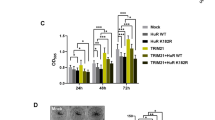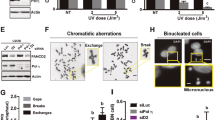Abstract
Eukaryotic cells respond to genotoxic stress by inducing cell growth arrest or apoptosis. Although the p53 tumor suppressor largely contributes to the response by regulating antiproliferative or pro-apoptotic genes, some genotoxic stresses including ultraviolet (UV) light induce apoptosis even in the absence of p53. The molecular mechanisms by which cells respond to UV in the p53-independent manner remain to be established. Here, we show that UV-induced stress promotes proteasome-dependent degradation of Tob, triggering an apoptotic signal. We found that Tob with either short deletion or a tag sequence at the C terminus was resistant to UV-induced degradation. Introduction of the degradation-resistant Tob impaired UV-induced apoptosis. Reciprocally, suppression of Tob by small interfering RNA (siRNA) resulted in frequent induction of apoptosis irrespective of the presence of functional p53 even at UV doses that do not promote Tob degradation. Finally, tob-deficient (tob−/−) mice and primary embryonic fibroblasts (MEFs) from tob−/− mice exhibit increased sensitivity to UV irradiation. Thus, proteasomal clearance of Tob provides a novel p53-independent pathway for UV-induced apoptosis.
This is a preview of subscription content, access via your institution
Access options
Subscribe to this journal
Receive 50 print issues and online access
$259.00 per year
only $5.18 per issue
Buy this article
- Purchase on Springer Link
- Instant access to full article PDF
Prices may be subject to local taxes which are calculated during checkout






Similar content being viewed by others
References
Bendjennat M, Boulaire J, Jascur T, Brickner H, Barbier V, Sarasin A et al. (2003). UV irradiation triggers ubiquitin-dependent degradation of p21WAF1 to promote DNA repair. Cell 273: 599–610.
Boiko AD, Porteous S, Razorenova OV, Krivokrysenko VI, Williams BR, Gudkuv AV . (2006). A systematic search for downstream mediators of tumor suppressor function of p53 reveals a major role of BTG2 in suppression of Ras-induced transformation. Genes Dev 20: 236–252.
Dornetshuber R, Heffeter P, Kamyar MR, Peterbauer T, Berger W, Lemmens-Gruber R . (2007). Enniatin exerts p53-dependent cytostatic and p53-independent cytotoxic activities against human cancer cells. Chem Res Toxicol 20: 465–473.
El-Mahdy MA, Hamada FM, Wani MA, Zhu Q, Wani AA . (2000). P53-degradation by HPV-16 E6 preferentially affects the removal of cyclobutane pyrimidine dimmers from non-transcribed strand and sensitizes mammary epithelial cells to UV-irradiation. Mut Res 459: 135–145.
Guardavaccaro D, Corrente G, Covone F, Micheli L, D'Agnano I, Starace G et al. (2000). Arrest of G(1)-S progression by the p53-inducible gene PC3 is Rb dependent and relies on the inhibition of cyclin D1 transcription. Mol Cell Biol 20: 1797–1815.
Hakem R, Hakem A, Duncan GS, Henderson JT, Woo M, Soengas MS et al. (1998). Differential requirement for caspase 9 in apoptotic pathways in vivo. Cell 94: 339–352.
Hiramatsu Y, Kitagawa K, Suzuki T, Uchida C, Hattori T, Kikuchi H et al. (2006). Degradation of Tob1 mediated by SCFSkp2-dependent ubiquitination. Cancer Res 66: 8477–8483.
Kondo T, Kobayashi M, Tanaka J, Yokoyama A, Suzuki S, Kato N et al. (2004). Rapid degradation of Cdt1 upon UV-induced DNA damage is mediated by SCFskp2 complex. J Biol Chem 279: 27315–27319.
Kuida K, Haydar TF, Kuan CY, Gu Y, Taya C, Karasuyama H et al. (1998). Reduced apoptosis and cytochrome c-mediated caspase activation in mice lacking caspase 9. Cell 94: 325–337.
Lackinger D, Kaina B . (2000). Primary mouse fibroblasts deficient for c-Fos, p53 or both proteins are hypersensitive to UV light and alkylating agent-induced chromosomal breakage and apoptosis. Mut Res 457: 113–123.
Latonen L, Laiho M . (2006). Cellular UV damage responses-functions of tumor suppressor p53. Biochim Biophys Acta 1755: 71–89.
Lavin MF, Gueven N . (2006). The complexity of p53 stabilization and activation. Cell Death Differ 13: 941–950.
Li P, Nijhawan D, Budihardjo I, Srinivasula SM, Ahmad M, Alnemri ES et al. (1997). Cytochrome c and dATP-dependent formation of Apaf-1/caspase-9 complex initiates an apoptotic protease cascade. Cell 91: 479–489.
McKay BC, Becerril C, Ljungman M . (2001). P53 plays a protective role against UV- and cisplatin-induced apoptosis in transcription-coupled repair proficient fibroblasts. Oncogene 20: 6805–6808.
Matsuda S, Tsuzuku J, Ohsugi M, Yoshida M, Emi M, Nakamura Y et al. (1996). Tob, a novel protein that interacts with p185ErbB2, is associated with anti-proliferative activity. Oncogene 12: 705–713.
Naik E, Michalak EM, Villunger A, Adams JM, Strasser A . (2008). Ultraviolet radiation triggers apoptosis of fibroblasts and skin keratinocytes mainly via the BH3-only protein Noxa. J Cell Biol 176: 415–424.
Norbury CJ, Zhivotovsky B . (2004). DNA damage-induced apoptosis. Oncogene 23: 2797–2808.
Ratner JN, Balasubramanian B, Corden J, Warren SL, Bregman DB . (1998). Ultraviolet radiation-induced ubiquitination and proteasomal degradation of the large subunit of RNA polymerase II. J Biol Chem 273: 5184–5189.
Rouault JP, Falette N, Guehenneux F, Rimokh R, Wang Q, Berthet C et al. (1996). Identification of BTG2, an antiproliferative p53-dependent component of the DNA damage cellular response pathway. Nat Genet 14: 482–486.
Saldeen J, Tillmar L, Karlsson E, Welsh N . (2003). Nicotinamine- and caspase mediated inhibition of poly(ADP-ribose) polymerase are associated with p53-independent cell cycle (G2) arrest and apoptosis. Mol Cell Biochem 243: 113–122.
Sasajima H, Nakagawa K, Yokosawa H . (2002). Antiproliferative proteins of the BTG/Tob family are degraded by the ubiquitin-proteasome system. Eur J Biochem 269: 3596–3604.
Smith ML, Ford JM, Hollander MC, Bortnick RA, Amundson SA, Seo YR et al. (2000). P53-mediated DNA repair responces to UV radiation: studies of mouse cells lacking p53, p21 and/or gadd45 genes. Mol Cell Biol 20: 3705–3714.
Suzuki T, Tsuzuku J, Ajima R, Nakamura T, Yoshida Y, Yamamoto T . (2002). Phosphorylation of three regulatory serines of Tob by Erk1 and Erk2 is required for Ras-mediated cell proliferation and transformation. Genes Dev 16: 1357–1370.
Tirone F . (2001). The gene PC3/TIS21/BTG2, prototype member of the PC3/BTG/TOB family: regulator in control of cell growth, differentiation, and DNA repair? J Cell Physiol 187: 155–165.
Tomicic MT, Christmann M, Kaina B . (2005). Apoptosis in UV-C light irradiated p53 wild-type, apaf-1 and p53 knockout mouse embryonic fibroblasts: Interplay of receptor and mitochondrial pathway. Apoptosis 10: 1295–1304.
Vogelstein B, Lane D, Levine AJ . (2000). Surfing the p53 network. Nature 408: 307–310.
Wang S-Y, Iordanov M, Zhang Q . (2006). c-Jun NH2-terminal kinase promotes apoptosis by down-regulating the transcriptional co-repressor CtBP. J Biol Chem 281: 34810–34815.
Wang X . (2001). The expanding role of the mitochondria in apoptosis. Genes Dev 15: 2922–2933.
Wei MC, Zong WX, Cheng EH, Lindstein T, Panoutsakopoulou V, Ross AJ et al. (2001). Proapoptotic BAX and BAK; a requisite gateway to mitochondrial dysfunction and death. Science 292: 727–730.
Woo M, Hakem R, Soengas MS, Duncan DS, Shahinian A, Kagi D et al. (1998). Essential contribution of caspase 3/CPP32 to apoptosis and its associated nuclear changes. Genes Dev 12: 806–819.
Yoshida H, Kong YY, Yoshida R, Elia AJ, Hakem A, Hakem R et al. (1998). Apaf1 is required for mitochondrial pathways of apoptosis and brain development. Cell 94: 739–750.
Yoshida Y, Nakamura T, Komoda M, Satoh H, Suzuki T, Tsuzuku J et al. (2003). Mice lacking a transcriptional corepressor Tob are predisposed to cancer. Genes Dev 17: 1201–1206.
Yoshida Y, Tanaka S, Umemori H, Minowa O, Usui M, Ikematsu N et al. (2000). Negative regulation of BMP/Smad signaling by Tob in osteoblasts. Cell 103: 1085–1097.
Zhao Y, Hamza MS, Leong HS, Lim C-B, Pan Y-F, Cheung E et al. (2008). Kruppel-like factor 5 modulates p53-independent apoptosis through Pim1 survival kinase in cancer cells. Oncogene 27: 1–8.
Zhang Q, Yoshimatsu Y, Hildebrand J, Frish SM, Goodman RH . (2003). Homeodomain interacting protein kinase 2 promotes apoptosis by downregulating the transcriptional corepressor CtBP. Cell 115: 177–186.
Zhou BS, Elledge SJ . (2000). The DNA damage response: putting checkpoints in perspective. Nature 408: 433–439.
Zong WX, Lindstein T, Ross AJ, MacGregor GR, Thompson CB . (2001). BH3-only proteins that bind pro-survival Bcl-2 family members fail to induce apoptosis in the absence of Bax and Bak. Genes Dev 15: 1481–1486.
Zou H, Henzel WJ, Liu X, Lutschg A, Wang X . (1997). Apaf-1, a human protein homologous to C. elegans CED-4, participates in cytochrome c-dependent activation of caspase-3. Cell 90: 405–413.
Acknowledgements
We thank Dr Seiji Takeuchi (University of Fukui, Japan) for technical advice about UV irradiation of animals, and Dr Robert Whittier (Institute of Medical Science, Tokyo, Japan) and Dr Marius Sudol (Weis Center for Research, Danville, PA, USA) for comments on the paper. We also thank members of our laboratory for scientific comments and valuable discussions. This study was supported by a grant for scientific research from the Ministry of Education, Culture, Sports, Science and Technology of Japan.
Author information
Authors and Affiliations
Corresponding author
Additional information
Supplementary Information accompanies the paper on the Oncogene website (http://www.nature.com/onc)
Supplementary information
Rights and permissions
About this article
Cite this article
Suzuki, T., Tsuzuku, J., Kawakami, K. et al. Proteasome-mediated degradation of Tob is pivotal for triggering UV-induced apoptosis. Oncogene 28, 401–411 (2009). https://doi.org/10.1038/onc.2008.387
Received:
Revised:
Accepted:
Published:
Issue Date:
DOI: https://doi.org/10.1038/onc.2008.387
Keywords
This article is cited by
-
TOB is an effector of the hippocampus-mediated acute stress response
Translational Psychiatry (2022)



